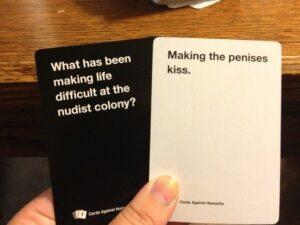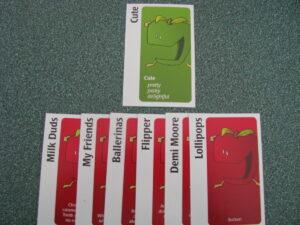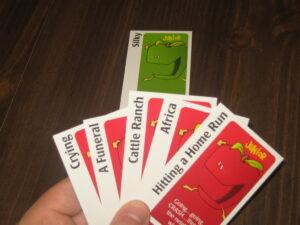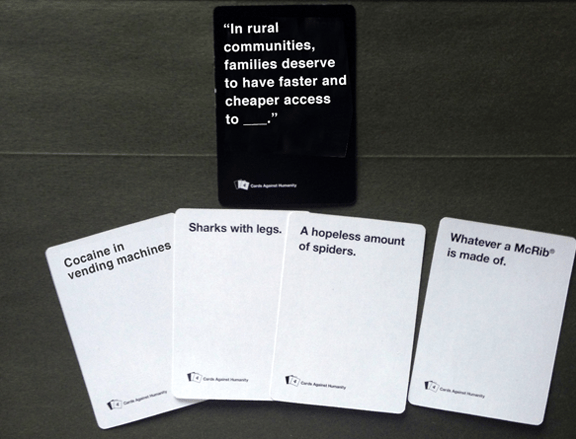Name of Game:
Cards Against Humanity
Creators:
Josh Dillon, Daniel Dranove, Eli Halpern, Ben Hantoot, David Munk, David Pinsof, Max Temkin & Eliot Weinstein
Platform:
Card Based Game
Target Audience:
The target audience for this game are older teens and adults who aren’t afraid to be a little risque and enjoy humor that often pushes boundaries of societal norms.
Argument:
Cards against humanity uses judgment as a way to provoke laughter and discomfort, but also in a way, acts like a mirror to the group dynamics at large. To expand on this point, because the mechanics of the game that make it so the outcome of each game relies on the judge for that round to choose the winning card, it can reveal what player knows the judge the best to know their sense of humor and know which card to play to make them laugh/get the point. Additionally, if you are playing with a group of people who aren’t afraid to push boundaries, that gives you some insight into what cards to play on your turn.
Analysis:
Diving into the mechanics of the game, Cards Against Humanities requires that for each round a player grabs a black card and reads the question listed on there that contains some fill in the blank, and all the remaining players must play a white card that they have that fills in the blank. The judge of that round selects the cards that they found most amusing, and the person who played that card wins that round. This mechanic of players anonymously placing cards in the middle allows players to separate themselves from the card they play, allowing for more unhinged gameplay as the personal responsibility is removed as people can play whatever card they want free of judgment. I think the game’s content of cards being a lot more risque and crude, can serve as a bonding experience as it creates a unique environment where you can laugh over content that would otherwise be inappropriate in any other setting. The fact that judges create their own criteria for which card they declare the winner, the player interactions are the most important dynamic within the game.
The most similar comparison to ‘Cards Against Humanity’ would be ‘Apples to Apples’, which Cards against humanity is said to have been based on. Unlike Apples to Apples, which is very family friendly and the questions/topics are a lot more tame, Cards Against Humanity pushes those social boundaries. See some of the comparisons below:
Cards against humanity:


Apples to Apples:


While the game is sure to get a good laugh, one critique I have of the overall design is that it relies too much on shock humor and topics that are otherwise taboo, in this case, i wouldn’t play this game at a family function with my mother for instance. While I think the inclusion of such cards makes it more entertainment for older players than an ‘Apples to Apples’, I think creating a more balance of nuanced cards that force layers to be creative in how they answer, can bring in some players who tend to be turned off by more taboo topics, knowing there are ways they can be strategic and still win rounds. It would expand on the potential market it can cater to if there were card packs within each game that contained levels of “taboo”, so that people who want something little more mature than Apples to Apples, but not outright discussing genitalia (see images above), they can still play and enjoy, likewise for people who want to wish those boundaries could use the pack of ‘taboo level 3’ cards, and be as vulgar and explicit as they want. While playing this game last weekend, one of the people I was playing with was’t as close to the rest of us and was a little more sensitive to such crude topics, and therefore wasn’t able to enjoy the game as much as the rest of us. By allowing there to be different tiers of “taboo-ness” allows larger groups of people to be able to play the game without feeling uncomfortable.



